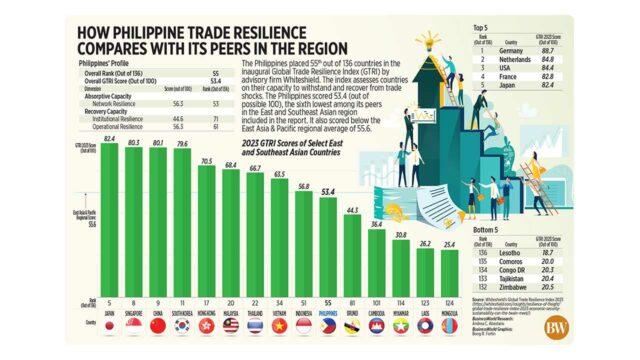No, it’s not a simple question of when the Bangko Sentral ng Pilipinas (BSP) and Monetary Board (MB) will finally reverse course and start slashing its monetary policy rate from the current 6.5%. Beyond commenting that tight monetary policy restricts credit and economic growth, our civil society should be clear why the BSP would rather choose to be constructively open as to when the transition will happen.
Actually, BSP Governor Eli Remolona could not have been clearer when he announced recently that easing policy rates will not likely happen within the first half of the year.
“I would say it’s possible but maybe not likely.”
It is all anchored on the data.
And the data should include the many Antonio Gabriel S. Pe Benitos of this nation of over 112 million who are all thinking of leaving the Philippines because of inflation (!). While Mr. Pe Benito simply complains about his meager income of P20,000 as a management trainee at a local consultancy firm, the International Labor Organization cast it more broadly: “The erosion of real wages and living standards by high and persistent inflation rates and rising costs of housing is unlikely to be offset quickly.” (“Philippine government told to carry through job plan amid grim outlook,” BusinessWorld, Jan. 22, 2024)
What about the latest Pulse Asia survey in December 2023 that indicated the persistent concerns of national respondents about the economy-related issues, topped by the need for government to control inflation? Some 72% of the respondents rated it first, followed by increasing workers’ pay, creating more jobs, and reducing poverty. Our people’s revealed preferences are not surprising. With empty, or near empty, stomachs, they would rather have lower consumer prices and better working conditions than tackle the roots of their misery such as graft and corruption, criminality, bad business, or the equally pressing issues of injustice and assault on our national sovereignty in the West Philippine Sea. We could not see anything but urgency for the authorities to keep their commitment to decisively battle inflation.
Just reading the report on the MB’s December 2023 policy meeting will tell us that the crusade against inflation is far from over. True, the baseline forecasts for 2024 and 2025 at 3.7% and 3.2%, respectively, are within the 2% to 4% target. But the newly minted risk-adjusted forecasts could be bothersome. This year, with risks considered, inflation could average 4.2%, breaching the target, and next year, around 3.4%. The BSP recognizes that the risks to the inflation outlook are, in their words, skewed to the upside through 2025. The BSP would not want to have another year in 2024 when the inflation target is exceeded. Its reputation as an inflation buster might be tarnished, and inflation expectations could be upset down the line. As they are, inflation expectations seem to have eased but they are not dissimilar from the BSP’s precarious baseline forecasts.
The MB press statement was quite clear on the inflation risks that include higher power and fuel rates, transport charges, and the prolonged dry spell through the second half of 2024. It also cited that price pressures could also build up if the temporary lowering of the tariff rates on certain basic commodities like rice and corn is not extended beyond end-December 2023. We cannot also discount the lagged effects of previous wage adjustments in all the regions of the Philippines starting in 2022.
In the last two weeks, we have seen that these risks are turning out to be true.
Both WTI and Brent oil futures have been rising as there is no end in sight to the hostilities in the Gaza Strip. As a result, we also observe and experience petrol pump prices becoming more volatile on the upside. Global industry experts also cite the long prospect of continuing upticks in oil prices following the involvement of both Pakistan and Iran in the on-going Middle East conflict.
With rising fuel prices, power rates are also bound to increase. What is sad is that last year, the Supreme Court reversed the decision of the Energy Regulatory Commission to limit the Wholesale Electricity Spot Market or WESM prices in the last two months of 2013. This will now allow power companies to charge higher power generation costs to customers starting this year through possibly the next couple of years.
On the transport side, as we wrote in our previous columns, the public utility vehicle modernization program could compel the riding public to pay more in order to help jeepney operators transition from traditional to modern jeepneys. Such a transition costs money for the jeepney operators who have no option but to charge riders higher fares. In addition, fare adjustments are expected this quarter for cabs, the MRT, and the traditional jeepneys.
The El Niño dry spell is expected to be a strong one this year. Pervasive could be an understatement as to its effects. First, it is expected to be prolonged, lasting until probably the end of the first half of 2024, but its impact could last for many months. Second, with lower water levels in the hydroelectric power plants and strong demand for alternative energy sources, power rates could be pushed higher. And third, we would expect the hit on domestic food production to be serious as in the past.
The recent admission by the BSP should be a good heads up on what to expect: “Supply shocks may derail our forecast including what’s going on with rice, the imports of rice. El Niño is a factor. So, it depends on those risks.” Of course, what could only derail the BSP forecasts is when the gravity of the supply shocks surpassed the magnitude of risks that has been factored into the risk-adjusted forecasts as announced last year.
If it does — and we hope it doesn’t — even the 2025 risk-adjusted forecast of 3.4% may have to be escalated.
But the non-monetary measures are not measuring up enough.
We find it pathetic that the National Government has allocated a measly P10 billion in aid to boost rice supply. This budget will allow the distribution of fertilizer discount vouchers under the Department of Agriculture’s Production Support Services under the National Rice Program. But what’s the use of fuel and fertilizer during El Niño when our farmers cannot plant at all? Better use this instead as a cash support to affected farmers to mitigate their livelihood. We expected a more fundamental approach to our local production. A Rice Outlook released by the US Department of Agriculture’s Economic Research shows that the Philippines is now the world’s No, 1 rice importer, importing about 3.8 million tons of rice, so much more than China, Indonesia, the European Union, Nigeria, and Iraq. This should be more than enough of a wake-up call!
We don’t have to emphasize that indeed in the short run, supply shocks could be material. Knowing their potential impact, households and corporates could be influenced in the way they form their inflation expectations. They can trigger secondary effects like wage adjustments and increases in transport fares and power charges. That is why central banks have to act fast and demonstrate their firm commitment to price stability and frustrate any potential build up in unfavorable inflation expectations.
It will be useful therefore for analysts and observers to cease questioning why central banks should be adjusting their policy rates when inflation is supply-driven. Focus more on the fact that core inflation ended the year 2023 at 6.6% compared to just 6% for the headline inflation, undeniably proof that demand pressures remain heavily at work. Focus more on the fact that despite the cautious monetary policy stance of the BSP, the economy, at 5.5% in the first three quarters last year, grew to be one of the fastest in the world even as base effects contributed a great deal here.
Nomura Global Markets Research recently commented — and commented well — on the virtue of the Philippines’ central bank, and that is continuing to signal patience with a policy pivot. “While inflation returned to target earlier than BSP’s forecast of the third quarter 2024, we do not see an immediate impact on monetary policy, given BSP remains cautious of upside inflation risks and remains hawkish.”
An easing soon?
It’s possible, but maybe not likely.
Diwa C. Guinigundo is the former deputy governor for the Monetary and Economics Sector, the Bangko Sentral ng Pilipinas (BSP). He served the BSP for 41 years. In 2001-2003, he was alternate executive director at the International Monetary Fund in Washington, DC. He is the senior pastor of the Fullness of Christ International Ministries in Mandaluyong.

















